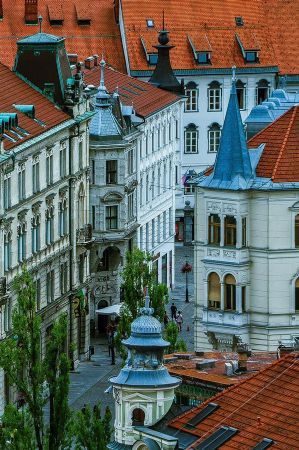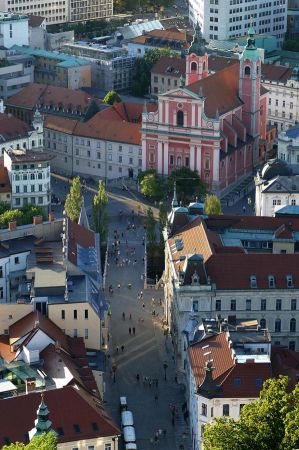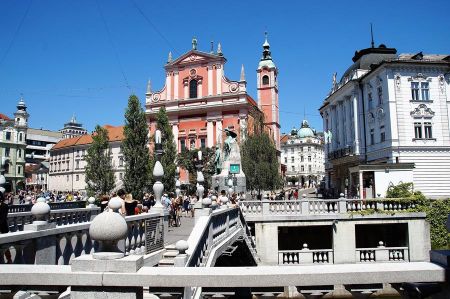Ljubljana - first impressions and historical background
- Written by Portal Editor
After arriving at the Camper Stop Princeplatz in Visjna Gora, we had a little bit in the place itself, also to explore the extremely attractive solution to reach the center of Ljubljana by train.
During the day, almost continuously half-hour there is the possibility to get to the city by train from Visjna Gora, the camper can safely stay on the site at the tennis court. Already for the next morning we wanted to use this possibility for the first time.
Ljubljana even received the honorary title “Reformation City of Europe”

Already from the early history of human settlements there are finds, so remains of the earliest sea containers (pile dwellings) from about 3600 to 3100 BC could be found in the Ljubljana moor. Between 1000 and 700 BC first Illyrian and Venetian settlements existed and around 400 BC the period of the Celts followed. In the 1st century BC a military fortress was erected by the Romans on the site of today's Ljubljana. In 14 AD the Roman settlement Emona (Colonia Emona Iulia tribu Claudia) was created. It was situated on the site of today's Ljubljana, but it was lost in the international migration and is therefore only a predecessor settlement of today's city.

In 1335, Ljubljana became the capital of the duchy of Carniola, which belonged to the Holy Roman Empire, among the Habsburgs. In 1415, Ljubljana resisted a Turkish invasion.
In 1511 Laibach experienced its first great earthquake. In 1536, Protestants established a professional Latin school in the gymnasium. In 1597, the Jesuits arrived in Ljubljana, which two years later established their own gymnasium. In 1693 the founding of the Academia Operosum followed, an association of the most distinguished scholars, and in 1701 the founding of the Academia Philharmonicorum followed this sample.
Railway connection Ljubljana–Vienna
In 1945, Ljubljana became the capital of the People's Republic of Slovenia in the Federative People's Republic of Yugoslavia. In 1958 the tram was shut down. In 1980 the Yugoslav president Josip Broz Tito died in Ljubljana. In 1991 the city of Slovenia celebrated independence.
the old town, which is a protected monument
• the Autonomous Youth Center Metelkova
• Jože Plečnik buildings, such as the Three Bridges (Tromostovje), NUK - the Slovenian National Library, Tivolipark
• the castle
• the Cathedral of St. Nicholas according to the plans of the Roman Jesuit Andrea Pozzo
• The Archbishop's Palace
• the Franciscan Church of the Annunciation at Prešernov trg To France Prešeren)
• the town hall
• The Serbian Orthodox Church of St. Cyril & Methodius
• Slovenian National Gallery
• the Moderna Galerija Art Museum
Ljubljana, on the other hand, resembles an Austrian city, but has a special Mediterranean young flair, thanks to its old town, the architecture of Plečnik's cultural circles, the many cafes along the river and the temperate climate.
In the summer, especially in August, various music events take place in the old town and on the castle, including the Music Academy in Ljubljana.
Tourism in the city has been experiencing a strong upturn for years, and room prices have also risen accordingly. Probably the one who is coming with an own camper has an advantage.
Ljubljana - First impressions and a little history
Ljubljana, the capital of Slovenia, is a city that you won't forget in a hurry. It combines historical elegance with modern charm and is one of the greenest and most livable capitals in Europe.
Anyone coming to Ljubljana for the first time will be amazed by the relaxed atmosphere, the picturesque streets of the old town and the lively cultural scene.
In this blog we take you on a journey through the first impressions that Ljubljana leaves on visitors and take a look at the exciting history of this fascinating city.
First impressions - What makes Ljubljana so special?
1. A city of bridges
The Ljubljanica River runs through Ljubljana, and beautiful promenades with numerous cafes and restaurants stretch along the water. The most striking are the unique bridges, including:
- The Dragon Bridge (Zmajski most) – The symbol of the city with the legendary dragon figures.
- The Triple Bridge (Tromostovje) – An architectural masterpiece by the famous Slovenian architect Jože Plečnik.
- The Butchers Bridge (Mesarski most) – Known for the many love locks that couples attach to the railings.
The Old Town of Ljubljana is a labyrinth of narrow streets, charming squares and impressive Baroque and Art Nouveau buildings. Particularly worth seeing are:
- Prešeren Square, the heart of the city with the Franciscan Church.
- St. Nicholas Cathedral, a magnificent baroque church with impressive ceiling frescoes.
- The Town Hall and Robba Fountain, two impressive buildings with Venetian influences.
3. Ljubljana Castle - A view over the city
Ljubljana Castle towers over the city and offers stunning views over the Old Town and the surrounding hills. It can be reached on foot or by cable car. In addition to the historical exhibition, the castle also has a restaurant and function rooms that are often used for cultural events.
A little history - The development of Ljubljana
Antiquity - Emona, the Roman settlement
The history of Ljubljana dates back to Roman times. The Roman city of Emona was founded here in the 1st century AD. Parts of the Roman walls and ruins can still be seen in the city today.
Middle Ages - From trading centre to capital
In the Middle Ages, Ljubljana became an important trading centre and developed into a prosperous city under the rule of the Habsburgs. Many of the buildings that still exist today date from this period.
The Habsburg period - A cultural centre
From the 14th to the 20th century, Ljubljana was part of the Habsburg Empire and later the Austro-Hungarian Monarchy. During this period, many important buildings were built in the Baroque and Art Nouveau styles, which still characterise the cityscape today.
20th century - The road to independence
After the war, Ljubljana became the capital of the Socialist Republic of Slovenia within Yugoslavia. It was not until 1991, when Slovenia gained independence, that Ljubljana became the capital of the new sovereign state.
Ljubljana today – A modern, sustainable and vibrant city
Today Ljubljana is a dynamic, young and sustainable city. It was awarded the "Green Capital of Europe" in 2016 and is strongly committed to environmental protection and sustainable mobility.
1. Car-free city center – A paradise for pedestrians
Ljubljana's city center is largely car-free, which makes exploring particularly pleasant. Instead, locals rely on bicycles or the electric minibus "Kavalir", which can be used free of charge.
2. Cultural highlights – Museums, art and festivals
- The Slovenian National Museum – The best address for an overview of the country's history.
- The Museum of Modern Art – With works by Slovenian and international artists.
- The Ljubljana Festival – An annual cultural highlight with concerts, plays and open-air events.
3. Culinary – Discover Slovenia's cuisine
Ljubljana is also a great place to try Slovenian specialties. Particularly popular are:
- Štruklji – Stuffed dough rolls with various fillings, sweet or savory.
- Kranjska Klobasa – The famous Slovenian sausage.
- Potica – A traditional Slovenian nut cake.
Many of the best restaurants can be found on the river bank, where you can enjoy the picturesque atmosphere.
Best time to visit and tips for your visit to Ljubljana
✔ Getting there: Ljubljana has its own airport and is easily accessible by train or bus from Austria and Italy.
✔ Accommodation: From charming boutique hotels to cozy guesthouses, there are many great places to stay.
Conclusion - Ljubljana, a city to fall in love with
Ljubljana is a city that you fall in love with at first sight. It is small but lively, historic but modern. The mix of stunning architecture, friendly atmosphere and a fascinating history makes it a perfect destination for a city trip.
If you visit Slovenia, you should definitely not miss the capital - it offers the best of history, culture and enjoyment in a relaxed, green environment.
Have you been to Ljubljana? Share your impressions in the comments!
Please read as well:
Passing the Karawanken Tunnel to Slovenia
Welcome to Camping Legjenda at Shkodra - Albania
-
-
-
-
-
-
-
-
-
-
-
-
-
-
-
-
-
-
-
-
-
-
-
-
